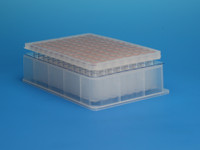Pulled Point Inserts in Plates

96-Well Plate with Glass Inserts
Chrom Tech’s 96-well plates with glass inserts provide the chemical inertness of high-purity glass within a standard microplate footprint—offering a powerful alternative to conventional polypropylene plates for tissue culture, ELISA, immunology, biochemical assays, and chromatography workflows. Each well contains a precision-formed glass insert, ensuring reliable performance with solvents, acids, and adsorption-prone analytes.
- Glass inserts create a fully inert, solvent-resistant microenvironment for sensitive or reactive samples
- Assembled plate delivers excellent thermal and dimensional stability for high-precision analytical work
- Pierceable cap mat seals both crimp-top and flanged inserts to maintain sample integrity during storage and handling
- Cap mat installs easily—no heat sealing or specialty equipment required
- Fully compatible with automated pipetting stations, autosamplers, and high-throughput robotic systems
Each glass-inserted 96-well plate performs similarly to a rack of 12×32 mm chromatography vials, providing familiar performance characteristics with the efficiency of a multi-well format. This design enhances sample recovery, reduces adsorption, and improves reproducibility across a wide range of analytical applications.
The integrated pierceable PTFE/silicone cap mat provides the same highly inert sealing chemistry used in standard LC/GC vial closures, ensuring a clean, airtight seal throughout preparation, storage, and injection. Together, the glass inserts and cap mat create a robust, contamination-resistant system ideal for demanding quantitative workflows.
Looking for More 96-Well Plate Options?
View the complete lineup of polypropylene, deep-well, glass-insert, and specialty plate formats.
Explore All 96-Well PlatesKey Definitions
▸A precision-formed glass vial seated inside a 96-well plate well, providing an inert and solvent-resistant microenvironment for sensitive analytical samples.
A PTFE/silicone sealing mat that covers all wells simultaneously, maintaining sample integrity while allowing autosampler needles to pierce through for injection.
A glass insert with a crimp-style rim, providing secure positioning within the well and compatibility with standard cap mat sealing systems.
A glass insert featuring a flared rim for stable seating in a multi-well plate and improved handling during automation workflows.
A chemically non-reactive surface that prevents adsorption and protects labile analytes—critical for chromatography and LC/MS sample prep.
The ability of the assembled plate and inserts to maintain dimensional consistency during heating or cooling, ensuring reproducible analytical results.
The standardized 8×12 microplate layout used for analytical, biochemical, and high-throughput screening workflows.
Frequently Asked Questions
▸Are 96-well plates with glass inserts compatible with standard autosamplers?
Yes. These plates maintain SBS/ANSI dimensions, making them compatible with most LC/MS autosamplers, robotic pipetting systems, and liquid handling platforms.
Why use glass inserts instead of polypropylene wells?
Glass provides a fully inert and solvent-resistant surface that prevents adsorption of peptides, metabolites, and labile analytes—improving recovery and reproducibility in chromatography and LC/MS workflows.
Do the sealed plates prevent evaporation or cross-contamination?
Yes. The pierceable PTFE/silicone cap mat provides an airtight seal across all wells, helping reduce evaporation, contamination, and sample loss during handling or autosampler injection.
Can the system be used with heat or thermal control?
Yes. The glass inserts and assembled multi-well plate provide strong thermal stability, supporting workflows requiring heating, cooling, or temperature-regulated sample processing.
Is specialized sealing equipment required?
No. The pierceable cap mat presses into place by hand—no crimping tool, heat sealer, or specialized equipment is necessary.
How do these plates compare to traditional chromatography vials?
Each well functions similarly to a 12×32 mm vial but in a more efficient high-throughput format, enabling parallel processing and automation while maintaining vial-level inertness and sample integrity.



